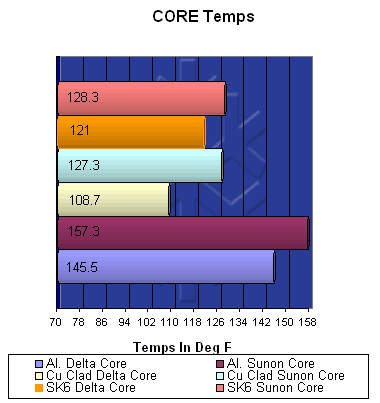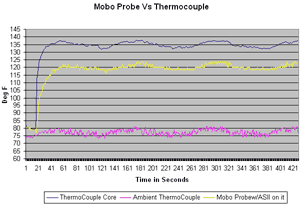|
|
|
|
 Cool-Innovations Vs ThermalRight SK6 Cool-Innovations Vs ThermalRight SK6
|
|
Date Posted: Jul 13 2001
|
|
Author: Joe
|
|
|
|
|
Posting Type: Review
|
|
Category: Air Cooling Reviews
|
|
Page: 3 of 3
|
|
Article Rank:No Rank Yet
Must Log In to Rank This Article
|
|
|
|
|
Note: This is a legacy article, imported from old code. Due to this some items on the page may not function as expected. Links, Colors, and some images may not be set correctly.
|
|
|
Cool-Innovations Vs ThermalRight SK6 By: Joe
|
|
ThermalRight SK6 Vs the Cool Innovations Pin HSF's
|
|
Data Breakdown - aka: Results
|
|
Now the part you have all been waiting for. The results. So without any more talk, lets get to cold hard numbers. ( or warm steamy ones... we are dealing
with HSF's after all)
|
|
|
Cool Innovations - Ultra Cool Aluminum ( CPC 30370)
|
|
|
|
|
|
Click for 700x500 40K full size GIF image
|
|
|
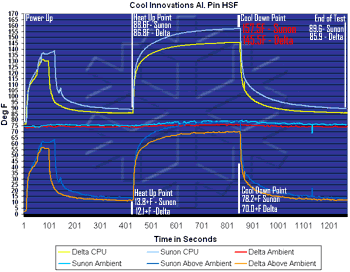 |
|
|
|
OK now that's one helluva complicated chart to just be able to look at and know what the deal is. So here's the break down:
|
|
Sunon 26CFM
|
Core
|
Ambient
|
Core Deg F Above Am.
|
|
Power Up
|
78.2
|
74.1
|
4.1
|
|
Heat Up
|
88.6
|
74.8
|
13.8
|
|
Cool Down
|
157.4
|
79.3
|
78.1
|
|
End of test
|
89.6
|
75.7
|
13.9
|
|
|
|
Delta 38CFM
|
Core
|
Ambient
|
Core Deg F Above Am.
|
|
Power Up
|
76.4
|
74.2
|
2.2
|
|
Heat Up
|
85.9
|
73.8
|
12.1
|
|
Cool Down
|
145.5
|
75.5
|
70
|
|
End of test
|
85.9
|
74
|
11.9
|
|
|
|
( THERE IS AN UPDATE AT THE BOTTOM OF THE PAGE!)
|
|
The Cool down temps are the Peak temps of the machine.
That is the last temps read right at the point the CPU's HEAT LOAD test ends. That SHOULD be the peak temp of the entire test. It was in both of these tests. These temps are the average for all the numbers from 3 tests for each fan.
Well the high speed, high noise Delta wins in this one ( duh) but the HSF didn't do so well overall.
145Deg F on a 50watt heat source is pretty mean. Let alone 160Deg F. The heat source just seamed to either overwhelm the HSF or it was just not getting the heat to where it needed to be ( spread out across the entire HSF). Well Lets see the other HSF's and then we will see how it fares compared to the other badies in this shoot out.
|
|
|
Cool Innovations - Ultra Cool Clad Base Aluminum/Copper
|
|
|
|
|
|
Click for 700x500 40K full size GIF image
|
|
|
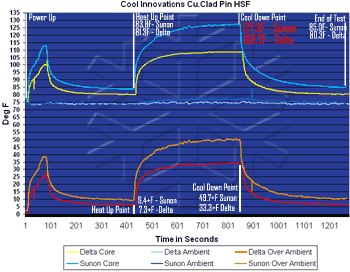 |
|
|
|
Sunon 26CFM
|
Core
|
Ambient
|
Core Deg F Above Am.
|
|
Power Up
|
77.2
|
74.9
|
2.3
|
|
Heat Up
|
83.8
|
74.4
|
9.4
|
|
Cool Down
|
127.3
|
77.6
|
49.7
|
|
End of test
|
85
|
74.7
|
10.3
|
|
|
|
Delta 38CFM
|
Core
|
Ambient
|
Core Deg F Above Am.
|
|
Power Up
|
75.3
|
74.9
|
0.4
|
|
Heat Up
|
80.2
|
73.9
|
6.3
|
|
Cool Down
|
108.7
|
74.8
|
33.9
|
|
End of test
|
80.3
|
74.2
|
6.1
|
|
|
|
|
( THERE IS AN UPDATE AT THE BOTTOM OF THE
PAGE!)
|
|
|
|
|
In this test we see a considerable improvement over the Al. HSF above! by 38DegF in some cases! That's a MASSIVE temp difference. The Difference
between the Delta and the Sunon was very noticeable this run more then the last run. Seems the Pin fins really like a lot of air coming at them and can be more efficient with the air then the Al. one which had a very
narrow difference with the Delta and the Sunon.
|
|
|
|
|
|
Click for 700x500 40K full size GIF image
|
|
|
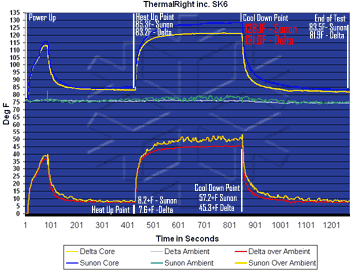 |
|
|
|
Sunon 26CFM
|
Core
|
Ambient
|
Core Deg F Above Am.
|
|
Power Up
|
76.1
|
76
|
0.1
|
|
Heat Up
|
85.3
|
77.1
|
8.2
|
|
Cool Down
|
128.1
|
75.4
|
52.7
|
|
End of test
|
83.5
|
74.8
|
8.7
|
|
|
|
Delta 38CFM
|
Core
|
Ambient
|
Core Deg F Above Am.
|
|
Power Up
|
75.3
|
74.9
|
0.3
|
|
Heat Up
|
83.2
|
75.6
|
7.6
|
|
Cool Down
|
121
|
75.7
|
45.3
|
|
End of test
|
81.9
|
74.3
|
7.6
|
|
|
|
|
( THERE IS AN UPDATE AT THE BOTTOM OF THE
PAGE!)
|
|
|
|
|
Uhh ohh.
The Current leader in HSF's looks like its been duped!! The Delta on the SK6 looks like it was better then a Sunon on the Cool Innovations, but the Delta on the Cool Innovations still holds firm the coolest cooler ranking in this shoot out. lets compare some stuff:
|
|
|
|
|
Delta Fan Comparison
|
|
|
|
For all the HSF's using Delta Fans there was almost 37DegF difference between the top and the bottom. That's one big ass difference. You
will notice the ambient lines for them all are almost all exactly the same or within 2 or 3 Deg. So blaming it on different environmental conditions isn't going to fly :)
No matter how the Delta worked, it was still too freak'n loud.
|
|
|
Sunon Fan Comparison
|
|
|
|
Someone should prolly tell Cool Innovations that lower is better on these charts :)
They have broke a new record for HSF's that I have seen. Almost 160DegF is mighty impressive! I am guessing this has everything to do with the poorly lapped bottom.
You see the distance shrink to less then 1 degree between the Cu Clad and the SK6 with the Sunon. Shows that the Al/Cu Cu Clad HSF is less
efficient and needs a lot more air to get the lower temp like above. But it shows something else... Seems the ThermalRight SK6 doesn't improve much between a 38CFM and a 26+ CFM fan.
|
|
|
|
|
|
|
Click for 700x500 40K full size GIF image
|
|
|
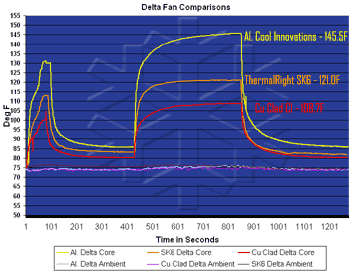 |
|
|
Click for 700x500 40K full size GIF image
|
|
|
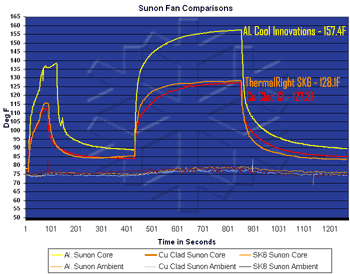 |
|
|
Well there isn't much confusion about who comes out ahead.
The Cool Innovations Cu. Clad Pin HSF is the leader in every category. The ThermalRight SK6 is right behind but lacks the surface area to pull off the win. The Aluminum UltraCool HSF, is just way off. Either I got a bad one, or the HSF just really doesn't perform well.( THERE IS AN UPDATE AT THE BOTTOM OF THE PAGE!)
|
|
|
|
|
So that's how the final shake out happened. The Cu and the Thermal right are not too far off from each other, but the Al. one is WAY out there
:)
Amazing a small 3mm plate of Cu can have that great of an increase on a HSF's capabilities.
There is so much more data in those graphs than I have talked about. Like the fact the Thermalright HSF heats up and cools down faster then
the clad based. This will give you the reader the opportunity to look at the core data itself and extrapolate your own conclusions from minute details I may have missed.
if you do see something in them that I missed, please let me know in the Pro/Chat! Thanks ( THERE IS AN UPDATE AT THE BOTTOM OF THE PAGE!)
|
|
|
|
|
Now lets have a lil Q &A:
Q: Where can I buy one of the Cu HSF's, where did you get yours from?
A:
I received it from KDComputers as a sample they got from Cool Innovations At last check, they will NOT be carrying these HSF's as the price point is somewhere around 50$ by the time they ship to you. At that price you are better off just with a SK6. You will have to contact Cool Innovations to find a reseller. You can get the ThermalRight SK6 and the CPC30370 at KDcomputers though.
Q: that CPU Stability test app you used on the Heat load tests, does that simulate the same heat as a game or application would?
A: Yep, it
just runs commands through the core to keep it locked at 100% use. Which is essentially the same thing apps do and games do. (that's what the CPU is there for :)
Q: Why didn't you let the CPU run for a longer period of time?
A:
Its not necessary. To run it longer will give you some higher peak temps, but the trends for the temp curves are established rapidly and after leaving one test run over night I gained no extra info that I could not extrapolate from the 21min test.
Q: Why didn't you use a Higher watt heat source like a 1.4Ghz Tbird, or a Pelt?
A: Why no Tbird? - I could, but no reason to.
50watts will still show where the HSF's fail or surpass eachother. If I saw them all running very close to the same scores I would have upped the wattage till I could see a difference, but they all seemed to stress a lil with the 50 watt source as is. Why not a pelt? Cause its a synthetic test that doesn't show you at all how the cooling device will react on a core. Different contact areas, different wattage's, and a non steady heat supply.
Q: How close to the water block round up are these kind of charts?
A:
Close, but in this review I have found some other ways to do charting and also data drill down, so in the Waterblock roundup they may be a lil different.
Q: How many temp readings took place in this test:
A:
Total was 32400 temp readings were logged and recorded. A lot of data eh? Each chart above has over 7200 temp readings making them up.
Q: I have an onboard Mobo temp probe, and your temps are WAY higher then mine!
A:
The Extech thermal probe is insulated with Silicone and Neoprene under it. It also has a excellent contact area which is enhanced with the Dow Corning HSF paste, with the dead center of the core. This will give an un paralleled reading compared to the hellishly inaccurate and and flaky mobo probe. Your core may be emitting a TON more heat then your lil probe can, or is allowed to detect just on the design if the mobo/cpu setup.
|
|
|
|
In some recent tests it seems the Numbers on both the Al. HSF and the Cu HSF were off.
I do NOT like retracting numbers and testings, but its the right thing to do as the graphs above may mis lead someone.
The Difference between the Motherboard Probe Vs the Thermocouple test probe
There's been some confusion on why the numbers are so much higher across the board from their normal numbers.
This is cause of the placement of the thermocouple. its directly under the die. The Mobo probe is off to the side and not in the best location to get accurate temp info. I ran a test with a Mobo Probe, Thermocouple, and Compunurse to Identify the Temp Delta between all 3 testing methods. ( the Compunurse had a trimmed probe right next to the core.)
|
|
In the pic to your right you can see the test I conducted.
it shows what I expected. The Thermocouple, due to its exact location under the core and being dope'd with thermal paste sees the core as the temp the ceramic under the core is. The Motherboard probe is 10 - 15 Deg Cooler and slower on the detection of heat and cool down cycles. This is due to its distance from the core. The Compunurse was even more off, mostly it registered cooler then the mobo probe and the Thermocouple.
The reason some people have had some issues with this testing methodology is simple. No one has done testing like this, and from this location on
the CPU. These temps may be more accurate but at the price that they are hard to compare to other tests done by other sites.
|
|
|
|
The Al. HSF:
In some later testing of the Al. HSF it showed that it was because of the springs I used along with the socket I had it on, that the temps were artificially
higher. With stronger springs the temps dropped to the 132Deg F Peak with a Sunon fan and with the Delta it peaked at 122DegF. Those numbers are with a 50watt heat supply.
|
|
The Cu. Clad HSF:
This is one I am VERY confused and frustrated by. I think the numbers for the Cu Clad HSF with a delta are off because of the thermocouple loosing contact
with the bottom of the core.
This is one of the only explanations I have come up with. Since the Clad base core was the first test I ran I remounted the thermocouple after cause I did some changes to the testing setup. This slipped my mind until last night when I was working on more debugging of the numbers.
In a second test at the same wattage the numbers were FAR different. The Clad base was in fact only 3 Deg Cooler then the Al. pin HSF Giving temps of 129DegF
with a Sunon and 122Deg
with a Delta. With the mobo probes weak performance it was reading temps that were about 10 or 15 Deg behind what the Thermocouples are recording. To verify these results I remounted the thermocouple 3 times and used a new thermocouple in the test that's been calibrated to 1DegC. (TypeK).
|
|
|
|
The new results Place the SK6 as the lead HSF in this shoot out as it beat both the other HSF's!
I did retest the SK6 and it was really quite even with the numbers in the test. The Mobo monitor again was 10 or 15 degrees ( at some points 20Deg.) cooler then what the thermocouple was.
|
|
|
|
I am sorry for any confusion or issues the previous
test data caused. As I said in the beginning of this shoot out this was a debugging test of this methodology and test gear. Every precaution will be taken in the future to guard against incorrect readings. I
am including the Mobo Monitor log graphs and readings with every test graph from now on to give you an idea of what your temp readings will look like as well as the thermocouple test results.
|
|
That's it folks.
The end of ProCoolings first but definitely not last Shoot Out. This is the first step in a long line of up coming features, and projects to give you a bit more info about the cooling gear you use.
Props go out to a few companies for helping in this project:
KDComputers
supplied all the HSF's, Thanks to them for that!
Arctic Silver supplied the thermal paste
and... well.. that's bout it :)
|
|
If you have any comments or Questions please email me at Joe@ProCooling.com
|
|
|
|
| Random Forum Pic |
 |
| From Thread: can we agree on the basis of "C" in C/W ? |
|
| | ProCooling Poll: |
| So why the hell not? |
|
I agree!
|
 67% 67%
|
|
What?
|
 17% 17%
|
|
Hell NO!
|
 0% 0%
|
|
Worst Poll Ever.
|
 17% 17%
|
Total Votes:18Please Login to Vote!
|
|






 Cool-Innovations Vs ThermalRight SK6
Cool-Innovations Vs ThermalRight SK6





